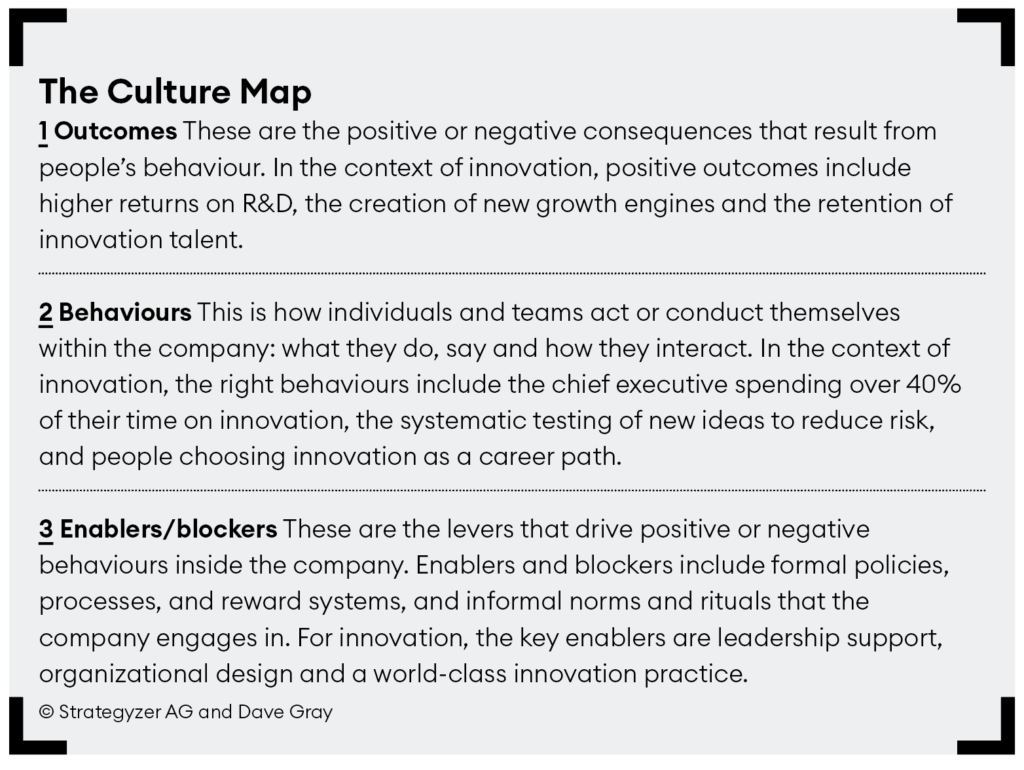The world’s most innovative cultures are built on a combination of leadership support, organizational design and great practices

What makes a business world-class at innovation? The companies we work with all invest a substantial amount of resources in innovation – yet they are almost always frustrated by the progress of their innovation teams. In our experience, this is usually the result of leaders failing to make a distinction between the way they manage their current business and how they should govern their innovation portfolio. Managing the existing and inventing the future requires two fundamentally different cultures that live side-by-side and co-exist in harmony. It means simultaneously exploiting the current business and exploring the future.
When exploiting your current successful business, you have a certain level of predictability, based on known customer purchases of your existing products and services. You know how much these customers are willing to pay, and how to reach them in order to deliver your products and services.
When exploring new ideas, the opposite is true. Now you are dealing with a level of uncertainty that you don’t have in your existing business. Most innovation teams working on new business ideas are still trying to figure out who their customers are and whether they can create the right value propositions to meet their needs.
We call an organization that manages both of the above well an ‘invincible company’. An invincible company is world-class at managing and improving the efficiency of its existing businesses, and is able to constantly reinvent itself at the same time. To achieve this, companies need to design and manage an innovation culture that complements their existing business. While efficiency innovation can succeed within the structures and processes of the existing business, transformative innovation – which explores future growth engines – needs a different style of leadership, organizational structures, processes and practices to thrive.
This type of ambidextrous organization is something people have been talking about for a while. What has been difficult for leaders is knowing how to build the right culture for the innovation side of the business.
How to establish an innovation culture
In our experience, a lot of companies let their culture emerge without actively designing it. We believe that leaders must play an important active role in the shaping of an innovation culture. This sounds trivial, but in practice we see leaders struggling with the topic. Culture cannot be built mechanically like engineering a car. Instead, an innovation culture needs to be cultivated like a garden. In order for the right flowers to bloom, experienced gardeners know that they need to pay attention to the content of the soil in which they are planting their flowers. The same is true for innovation. Leaders need to pay attention to the organizational context in which they are planting innovative new ideas.

From our perspective, a company’s culture has three main elements: Outcomes, Behaviours, and Enablers/Blockers, as presented in our Culture Map. For innovation to thrive, leaders cannot directly shape people’s behaviours and organizational outcomes. Instead, what leaders have is the power to remove blockers and create the right enablers for innovation. This fundamental layer of a culture is the soil in which innovative new ideas will be planted. Positive outcomes from innovation will result from people engaging in the right behaviours; these, in turn, are the result of leaders removing blockers and putting in place the right enablers, namely leadership support, organizational design and innovation practice.
Leadership support: make innovation a strategic priority
The most important enabler of innovation is leadership support. Without it, most innovation programmes are dead on arrival. Leadership support is reflected in how much time and attention leaders give to innovation. We believe that innovation will not thrive if the chief executive spends less than 40% of their time on it. A lack of attention at the top sends the message that innovation is a sideshow that is not central to the future growth of the business.
Beyond investing time, leaders need to provide clear strategic guidance on where they want their innovation teams to work, and then allocate protected resources to fund that chosen direction. When Bracken Darrell took over the helm of Logitech in 2013, it was clear that the company’s PC peripherals business was in decline. Darrell set the organization on a new strategic course, moving away from peripherals into consumer and enterprise accessories. This strategic decision was backed by the reallocation of 75% of resources from the old business to the new growth opportunities.
Logitech is a great example of how innovation can thrive in an organization where the leaders ‘put their money where their mouth is’. Instead of trying to pick the winning ideas themselves, leaders provide clear strategic guidance to the company. They can then manage a portfolio in which they make multiple small bets and increase investment only in those ideas that are showing success.
Organizational design: give innovation power
The next important enabler of innovation is organizational design. This speaks to whether innovation has legitimacy and power within the organization. To have impact, innovation must feature on the organizational chart at the very top where it has power. In most organizations there are two or three layers of authority between the head of innovation and the chief executive. This sends a message about the importance and urgency of innovation to the company.
If the chief executive cannot personally invest the necessary time to drive innovation and invent the future of the organization, then the company board must appoint a chief entrepreneur with equal power to the CEO. In 2008, Peter Ma, chief executive, chairman and founder of Ping An Insurance Group, started shifting the company from being a financial conglomerate to becoming a technology company. To drive this change, Ma appointed Jessica Tan as co-chief executive, with an explicit mandate to drive innovation. This allowed Ping An to successfully develop an innovation portfolio that includes breakthrough technology platforms like OneConnect and Good Doctor.
Furthermore, in an invincible company, there are clear policies that support the collaboration of innovation teams and the core business. Without such collaborations, innovation teams are ‘start-ups in chains’: lacking the freedoms of real start-ups while also missing out on the benefits of the established company’s resources.
When there is a bridge to the core, innovation teams can leverage the company brand, its access to customers and its product development capabilities.
Innovation practice: develop the profession
The final enabler of innovation is having a world-class practice. Leaders need to ensure that their teams master a set of dedicated innovation tools, such as the Value Proposition Canvas and Business Model Canvas, which help teams to design and test their offerings and business models. What really matters, however, is a management process focusing on the reduction of risk from new business ideas.
As we describe in The Invincible Company, leaders can track a set of innovation metrics while teams are doing the work of experimentation and iteration. And to help drive the right behaviours, leaders must implement innovation key performance indicators (KPIs) that are distinct from the KPIs used to drive the core business.
Finally, invincible companies also systematically develop world-class innovation talent to ensure that their innovation tools are used the right way. As with any profession, you get better with practice.
In one pharmaceutical company, we helped train and develop a group of internal innovation coaches. They were responsible for supporting the organization’s innovation teams globally, and they planted the seeds of an innovation community that would increase the company’s innovation capabilities over time.
In search of the entrepreneurial chief executive
In our work and research on invincible companies, we’ve discovered that one of the biggest levers for developing an innovation culture is giving legitimacy and power to innovation. Invincible companies need entrepreneurial chief executives, or alternatively, a tandem of CEO and chief entrepreneur.
In either case, these leaders need to be great at managing the core business while simultaneously building new growth engines. They need to understand that they cannot pick the winning ideas themselves. Instead, they empower their teams to design and test innovative new business ideas.
What the leadership team works on is building a supportive innovation culture. They get rid of all the blockers that prevent innovation from thriving, and they leverage enablers to drive the right behaviours. Over time this produces great outcomes through increased revenues and profits, and the retention of innovation talent.
While the cultures of exploration and exploitation must be separate, they need to coexist in harmony. Innovation, while separate, should not live too far away from the main business. The role of entrepreneurial leaders is to manage the contradictions and conflict that may arise from these two cultures collaborating. Do that well, and invincibility beckons.

